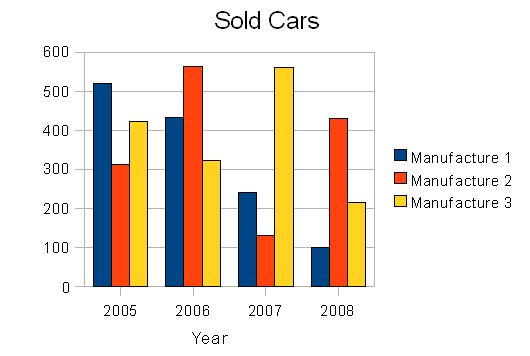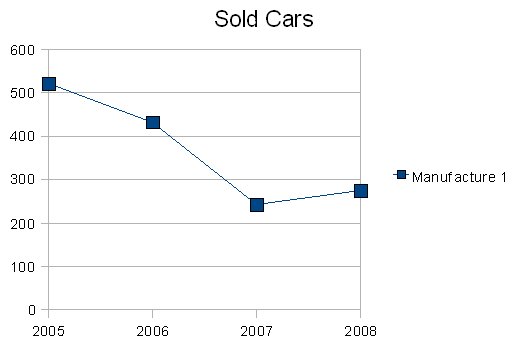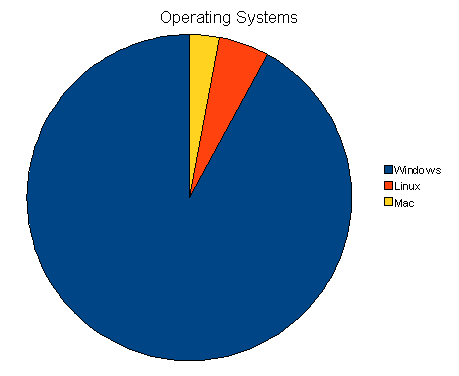Teaching:TUW - UE InfoVis WS 2008/09 - Gruppe 08 - Aufgabe 1 - Chart
Definitions[edit]
Overview[edit]
The term chart can stand for several different things. A chart might be a diagram, maps that hold additional information depending on their usage or music charts that represent the popularity of different tracks. Charts are used to provide people a fast and better understanding of large amount of data. Therefore they depend strong on graphical elements and hold only a limited amount of text for example a title to give a quick idea what the chart is about. Examples could be to show the population of a country over the last years. Using for example a line chart, an increase or a decrease of the population is easier to see then comparing plane numbers only.
Types of charts[edit]
Depending on the available data and the information somebody is willing to provide different kinds of charts exist since different information can be visualized better in one type of chart than another. Some of the most common are listed below and explained in more detail.
Bar chart[edit]

Bar Charts are composed out of several bars usually with equal width while the hight expresses the value. The bars can be horizontal or vertical oriented. Usually they are used to compare two ore more different values. A bar charts can be used for example when the data can be counted. For example how many people use the bus, the train or the car to go to work. Another example could be to show how many buyers of an iMac previously used a Windows PC, a Macintosh or used no PC before.
Histogram[edit]
Same as the bar chart the histogram uses bars to display the data. Different to a bar chart, on a histogram the bars are ordered only horizontal. A histogram is used to visualize continuous data, displaying the shape of a distribution, while the bar chart visualizes discrete data. For every point in the distribution a value exists. The points might be grouped into class intervals with an according frequency. The Result are bars with different hights depending on the frequency and the width of the bars depending on the size of the intervals.
Line chart[edit]

A Line Chart holds several related values. This values are connected with each other from left to right to show a tendency of the given data. As an example of usage could be the speed of a given body over some time.
Pie chart[edit]

A Pie chart is drawn in form of a circle. The different data values are encoded as segments. The relative values are used to define the arc length of the segments. A pie chart can be used if it should visualize the value of one segment compared to the rest of the chart. Comparing different segments which each other might be difficult for humans. Also displaying increase or decrease of values other charts can be a better choice.
Gantt chart[edit]
A Gantt chart is used for scheduling an amount of tasks. The horizontal axis is used to represent the time. The vertical axis holds the different tasks. Inside the plane horizontal bars are used to display the tasks where the length of the bar determines the time needed to fulfill the task. Displaying the dependency of the different tasks can only be done in a limited way using a Gantt chart. Other Charts as for example a PERT chart are more suitable for such a task.
Other charts[edit]
- Timeline chart
- Organizational chart
- Tree chart
- Flow chart
- Bubble chart
- Radar chart
References[edit]
- [Wikipedia 1, 2008] Wikipedia contributors, Chart. Wikipedia, the free encyclopedia. Retrieved at: November 02, 2008. http://en.wikipedia.org/wiki/Chart
- [Wikipedia 2, 2008] Wikipedia contributors, Bar chart. Wikipedia, the free encyclopedia. Retrieved at: November 03, 2008. http://en.wikipedia.org/wiki/Bar_chart
- [Skymark 1, 2008] SkyMark Corporation, Bar Charts. Bar charts are easy to use, and easy to abuse. Know the difference. Retrieved at: November 03, 2008. http://www.skymark.com/resources
- [Openlearn 1, 2008] Open Learn contributors, More working with charts, graphs and tables 5.1 Bar charts. OpenLearn Learning Space. Retrieved at: November 03, 2008.http://openlearn.open.ac.uk
- [Connexions 1, 2008] David Lane, Graphing Qualitative Variables. Rice University. Retrieved at: November 13, 2008.http://cnx.org/
- [Skymark 2, 2008] SkyMark Corporation, Histograms: Snapshots of Process Variation. Bar charts are easy to use, and easy to abuse. Know the difference. Retrieved at: November 03, 2008.http://www.skymark.com
- [Openlearn 2, 2008] Open Learn contributors, More working with charts, graphs and tables 5.3 Histograms. OpenLearn Learning Space. Retrieved at: November 03, 2008.http://openlearn.open.ac.uk
- [Connexions 2, 2008] David Lane, Histograms. Rice University. Retrieved at: November 13, 2008.http://cnx.org/
- [Wikipedia 3, 2008] Wikipedia contributors, Pie chart. Wikipedia, the free encyclopedia. Retrieved at: November 03, 2008. http://en.wikipedia.org/wiki/Pie_chart
- [Skymark 3, 2008] SkyMark Corporation, Pie charts: Still useful after all these years. Bar charts are easy to use, and easy to abuse. Know the difference. Retrieved at: November 03, 2008. http://www.skymark.com
- [Openlearn 3, 2008] Open Learn contributors, More working with charts, graphs and tables 6.1 What is a pie chart? OpenLearn Learning Space. Retrieved at: November 03, 2008. http://openlearn.open.ac.uk
- [Wikipedia 4, 2008] Wikipedia contributors, Line chart. Wikipedia, the free encyclopedia. Retrieved at: November 03, 2008. http://en.wikipedia.org/wiki/Line_chart
- [SearchSoftwareQuality, 2008] SearchSoftwareQuality contributors, What is Gantt chart. SearchSoftwareQuality.com Definitions. Retrieved at: November 03, 2008. http://searchsoftwarequality.techtarget.com